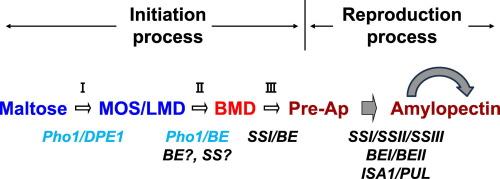Contents and structures of branched and linear maltodextrins, malto-oligosaccharides, and sugars in the early developmental stage of phosphorylase1 mutant endosperm of rice
IF 10.7
1区 化学
Q1 CHEMISTRY, APPLIED
引用次数: 0
Abstract
Biochemical analysis of plastidial phosphorylase (Pho1)-deficient mutants of rice strongly suggests that Pho1 plays an important role in the initiation of starch biosynthesis in the endosperm. The present study examined structures and amounts of maltodextrins, malto-oligosaccharides (MOS) as well as sugars in maturing rice endosperm and compared between a pho1-mutant line EM633 and its wild-type cultivar Taichung-65 (TC65). By using a gel permeation HPLC from developing rice endosperm of both lines, branched maltodextrins (BMD) with distinct fine structure could be isolated for the first time, a possible intermediate in the initiation process of starch biosynthesis, whereas its amount was much lower than starch content in both endosperms. This suggests that BMD as a main intermediate in the de novo synthesis of starch molecules is kept to be at a very low level during starch biosynthesis. The amounts of maltose, and MOS as well as linear maltodextrins (LMD) were greatly increased by the pho1 mutation. These results indicate that Pho1 would play an essential role in the step of mobility of maltose to MOS and then to LMD in the de novo synthesis of amylopectin molecules in developing rice endosperm.

水稻磷酸化酶1突变体胚乳发育早期的支链和线型麦芽糊精、麦芽寡糖和糖的含量及结构
对水稻质粒磷酸化酶(Pho1)缺陷突变体的生化分析强烈表明,Pho1 在胚乳淀粉生物合成的启动过程中发挥着重要作用。本研究考察了成熟水稻胚乳中麦芽糊精、麦芽寡糖(MOS)以及糖类的结构和含量,并比较了 pho1 突变株系 EM633 与野生型栽培品种 Taichung-65 (TC65) 之间的差异。利用凝胶渗透高效液相色谱法从两个品系发育中的水稻胚乳中首次分离出了具有独特精细结构的支链麦芽糊精(BMD),它可能是淀粉生物合成起始过程中的中间产物,但其含量在两个胚乳中都远远低于淀粉含量。这表明,在淀粉生物合成过程中,BMD 作为淀粉分子从头合成的主要中间体一直处于极低水平。pho1突变后,麦芽糖、MOS和线性麦芽糊精(LMD)的含量大大增加。这些结果表明,在发育中水稻胚乳的直链淀粉分子从头合成过程中,Pho1 在麦芽糖到 MOS 再到 LMD 的移动过程中起着至关重要的作用。
本文章由计算机程序翻译,如有差异,请以英文原文为准。
求助全文
约1分钟内获得全文
求助全文
来源期刊

Carbohydrate Polymers
化学-高分子科学
CiteScore
22.40
自引率
8.00%
发文量
1286
审稿时长
47 days
期刊介绍:
Carbohydrate Polymers stands as a prominent journal in the glycoscience field, dedicated to exploring and harnessing the potential of polysaccharides with applications spanning bioenergy, bioplastics, biomaterials, biorefining, chemistry, drug delivery, food, health, nanotechnology, packaging, paper, pharmaceuticals, medicine, oil recovery, textiles, tissue engineering, wood, and various aspects of glycoscience.
The journal emphasizes the central role of well-characterized carbohydrate polymers, highlighting their significance as the primary focus rather than a peripheral topic. Each paper must prominently feature at least one named carbohydrate polymer, evident in both citation and title, with a commitment to innovative research that advances scientific knowledge.
 求助内容:
求助内容: 应助结果提醒方式:
应助结果提醒方式:


